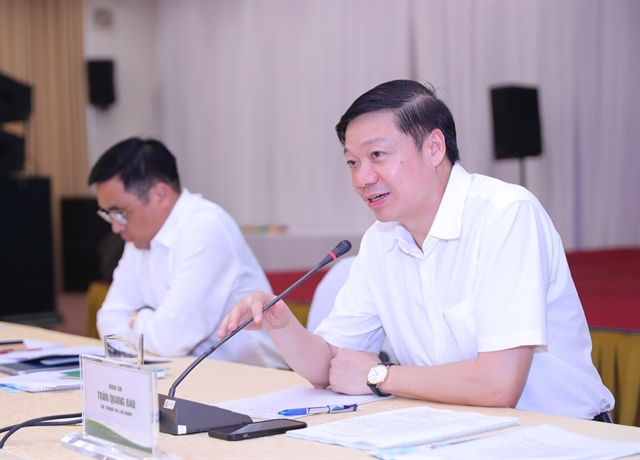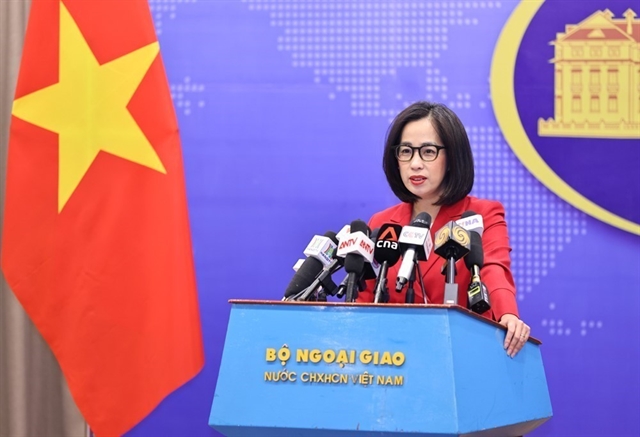 Opinion
Opinion

 |
| Trần Quang Bảo, director of the Ministry of Agriculture and Rural Development’s Department of Forestry. — VNA/VNS Photo |
Participating in carbon credit trading to reduce emissions will contribute to improving the lives and livelihoods of ethnic minority communities. Viet Nam News reporter Trần Tố Như spoke with Trần Quang Bảo, director of the Ministry of Agriculture and Rural Development’s Department of Forestry, about this issue.
Could you provide specific information about the results of carbon credit trading in the carbon market that Việt Nam has implemented?
In line with the Government's commitment to achieving net-zero emissions by 2050, the forestry sector has advised the Government to engage in international initiatives and programmes aimed at reducing emissions resulting from deforestation and forest degradation.
In pursuit of this goal, we have established and implemented agreements and negotiations for the transfer of forest carbon credits for regions with potential for forest restoration and increased carbon sequestration.
Currently, Việt Nam has signed an Emission Reduction Payment Agreement (ERPA) with the World Bank for six localities in the north central region, in line with a REDD+ carbon credit transaction. This agreement covers the transfer of 10.3 million tonnes of carbon dioxide equivalent at a price of US$5 per ton, and 95 per cent of this volume will be counted towards Việt Nam's Nationally Determined Contribution (NDC).
As of now, the legal procedures and preparations are in place, and the World Bank has already disbursed 80 per cent of the total budget, which is equivalent to $41.2 million, to Việt Nam.
Regarding the south central and central highlands regions, during the 26th United Nations Climate Change Conference of the Parties (COP26), under the Prime Minister's witness, the Minister of Agriculture and Rural Development and the Director of the Organisation for Forest Financial Enhancement (EMERGENT) signed a Letter of Intent on emissions reduction. This serves as the basis for formal negotiations, signing, and the implementation of a forest carbon credit purchase agreement for 11 localities in the south central and central highlands regions.
According to this Letter of Intent, Việt Nam is expected to transfer 5.15 million tonnes of carbon dioxide equivalent emissions reductions from forests in the south central and central highlands regions for the period of 2022-2026, at a minimum price of $10 per tonne of carbon dioxide equivalent. All transferred carbon credits will be counted towards Việt Nam's NDC.
Since signing the Letter of Intent, the Department of Forestry has closely cooperated with EMERGENT to advance the Lowering Emissions by Accelerating Forest Finance (LEAF) Coalition’s initiative and ensure its progress.
Việt Nam is one of the pioneering countries to engage in this commitment. Currently, EMERGENT has visited Việt Nam to conduct workshops and on-site consultations in the north central and central highland regions.
After these workshops and field trips to different regions, including consultations with relevant parties and particularly ethnic minority communities in forested areas, formal negotiations and the implementation of emissions reduction measures will follow.
Based on the results of monitoring emissions reduction from 2021 to 2025, and considering additional emissions reductions, negotiations will continue at market-based rates.
A positive aspect of the negotiation with this organisation is that Việt Nam will receive a 100 per cent reimbursement for all transferred carbon credits purchased by businesses and countries that have committed to buying them. This reflects Việt Nam's proactive approach to fulfilling international commitments, mobilising financial resources outside the budget, and supporting ethnic minority communities, especially those directly involved in forest protection and the vital role that tropical forests play in biodiversity conservation, disaster risk reduction, and environmental protection in mountainous and remote areas.
In addition to the north central and central highland regions, the organisations are also showing interest in other forest types such as mangroves and lowland forests in the northern midlands and mountainous region.
The Department of Forestry will continue to advise the Ministry of Agriculture and Rural Development to support the Prime Minister in developing a plan for transferring emissions reductions that ensures national interests in fulfilling the Government's commitment to reducing emissions and mobilising financial resources to support forest protection and development in the near future.
Could you share about the fund for the 10 million tonnes of carbon dioxide equivalent emissions reductions in the north central region? How will the disbursement plan be implemented?
At present, the World Bank has already transferred 80 per cent of the funds to the Việt Nam Forest Protection and Development Fund, which amounts to approximately $41.2 million.
Currently, local authorities are opening accounts to receive the funds and developing plans to share benefits in accordance with the financial management trial agreement and the transfer of emissions reduction results.
The majority of the funds will be directly disbursed to forest owners, especially the communities actively involved in forest development and livelihood support for ethnic minority populations, in accordance with the commitments and negotiation agreements signed by the World Bank with international organisations.
We hope that the proper, sufficient, and timely disbursement of these funds will provide a source of motivation for the communities directly involved in forest conservation.
So, up to this point, has Việt Nam sold more than 15 million tonnes of carbon dioxide equivalent emissions reductions?
For the agreements in the north central, south central and central highland regions, international negotiation organisations typically estimate figures based on the reference period for emissions reduction scenarios.
Through calculations, in the north central region, we expected to transfer 10 million tonnes of carbon dioxide equivalent emissions reductions in three phases. However, in just the initial phase (2018-2019), we already exceeded the 10 million tonnes, so there is expected to be an excess amount.
This is similar in the south central and central highlands region. According to the Letter of Intent, it's 5.15 million tonnes of carbon dioxide equivalent emissions reductions. However, after independent auditing reports from international organisations, there is expected to be an excess amount.
With the excess amount, once specific reporting figures are available, the Department of Forestry will provide detailed reports to the Ministry of Agriculture and Rural Development and the Prime Minister to request permission to negotiate and continue the transfer of these emissions reductions, ensuring maximum disbursement for Việt Nam and the fulfilment of emissions reduction commitments, as well as the best interests in the global carbon market transactions.
The 15 million tonnes of carbon dioxide equivalent emissions reductions is quite modest compared to Việt Nam's potential. How do you assess the possibility of increasing this figure in the future?
Based on preliminary estimates through forest resource monitoring cycles across the country, every year, Việt Nam's emissions reductions through improved forest quality could reach nearly 80 million tonnes of carbon dioxide. After accounting for the emissions reduction commitments for each region, we could have a surplus of approximately 40 million tonnes of carbon dioxide, which we can participate in the international carbon credit market.
However, converting forest carbon sequestration into tradable carbon credits to mobilise financial resources will be a long process. We've currently completed the first step, which is the transfer of emissions reduction results and the conversion of carbon sequestration into internationally tradable carbon credits.
The next phase involves implementing agreements in the south central and central highland regions through transfers with the EMERGENT, following the TREES credits and potential international market transactions.
Furthermore, in other potential regions, the Ministry of Agriculture and Rural Development will continue to advise the Government to ensure the interests of local authorities and forest owners while adhering to international standards and regulations. – VNS




